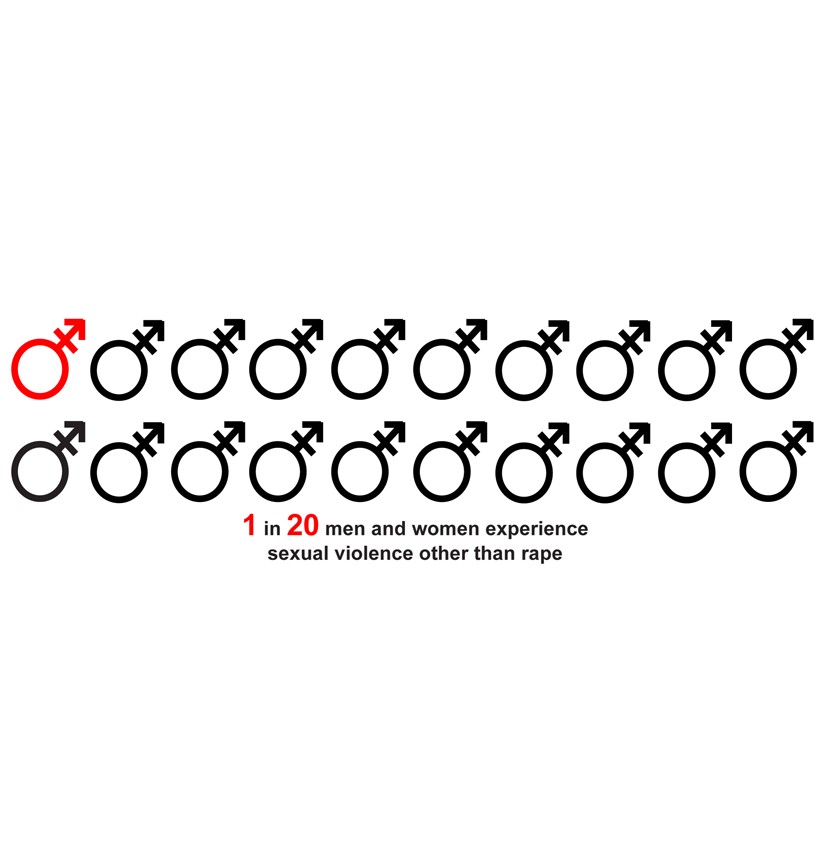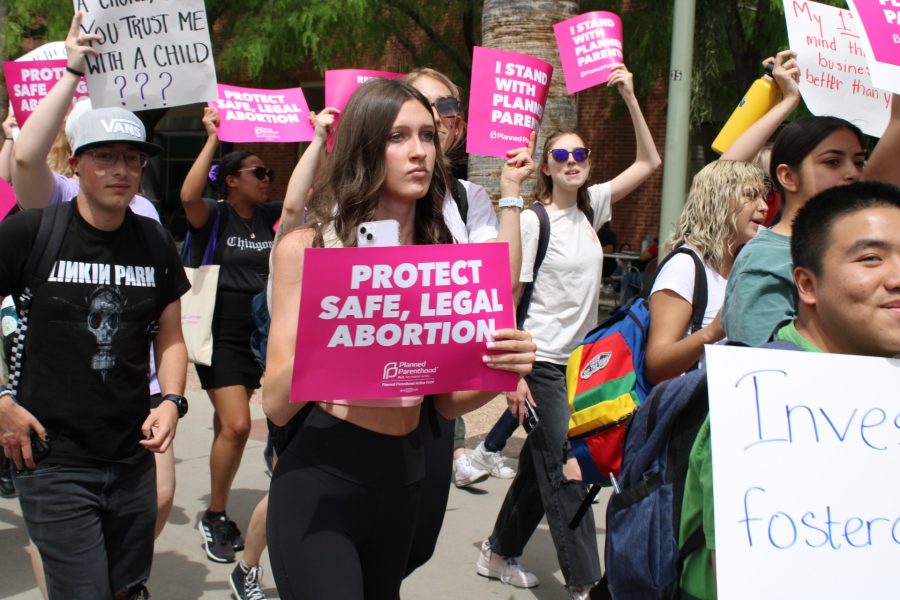Anna woke up to a strange man lying on top of her, his hands touching her breasts and between her legs over her clothes.
The bedroom was dark, with just a little light creeping through a curtained window.
It was after 2 a.m., and she had fallen asleep at her best friend’s apartment after a party.
A sophomore at the UA, Anna had been designated as the sober person who, should anything go wrong, would help guests find rides home or drive them wherever they might need to go.
“Just to make sure that there was someone there so that it was safe,” said Anna, now a senior studying classics whose name has been changed to protect her privacy.
After everyone who wasn’t staying the night had left, Anna went to bed.
The only girl left in the apartment, she slept in a different room than everyone, only to wake up to find she was being sexually assaulted by a man she barely knew.
“It took me a couple of minutes to realize what was happening,” she said. “It’s almost like the monster underneath the bed is real … This is the thing that you’ve heard in so many school seminars. So many people have told you don’t let this happen to you … all of a sudden it’s there, it’s real, it’s happening to you.”
After pushing the man off her, Anna left the room. She checked the other rooms to be sure no other girls were sleeping in the apartment, grabbed her keys and went home.
“I felt like I was in really grave danger,” Anna said.
But like many other sexual assault survivors, Anna never reported the assault to authorities.
It’s not uncommon
Nearly one in every five women nationally are raped at some point in their lives, and nearly one in every 20 women and men experience sexual violence other than rape, according to data published in 2012 by the Centers for Disease Control and Prevention. Data from the CDC also showed that 19 percent of undergraduate women who were surveyed reported experiencing attempted or completed sexual assault since entering college.
Yet during the same year, University of Arizona Police Department statistics only showed nine reports of forcible sexual offenses for the UA Main campus.
“Those numbers … are much lower than what is truly happening on campus,” said Megan McKendry, violence prevention specialist with the OASIS Program through Campus Health Services. “There are reasons for that. The first is that sexual assault … we just know it to be the most underreported crime on campus, because reporting is incredibly difficult for survivors.”
There are several sets of sexual assault statistics across campus, including reports to OASIS, which provides counseling services for students, faculty and staff, the Dean of Students Office and UAPD, though each has its own limitations.
For example, a client who reports sexual assault to OASIS may be reporting something that occurred when they were a child, or a few years prior as a freshman, McKendry said.
For a more accurate sense of how many people have been raped or sexually assaulted on campus, Campus Health administers a Health and Wellness Survey each year.
During the 2012-2013 academic year, Campus Health surveyed 3,055 undergraduate students, of which 2.3 percent, or approximately 70 students, reported having some type of sex without giving their consent, 8.5 percent, or approximately 260 students, reported being sexually assaulted.
However the survey does not reveal anything about those reporting the assaults, McKendry said.
During the same time period, OASIS saw just 40 clients in reference to sexual assault, according to Kathy Young, a psychologist for Counseling and Psych Services (CAPS) at Campus Health. The Dean of Students Office also saw around 40 cases of sexual misconduct during this time, according to Alexx Tracy-Ramirez, former Title IX investigator for the Dean of Students Office.
The challenges of reporting
In general, sexual assault victims are likely to not want to report to the police, Young said.
“Unfortunately our culture still tends to blame victims for their sexual assaults,” she said, “rather than hold the perpetrators accountable.”
Victims may be afraid that people will not believe them if they come forward, or they’ll be blamed, she added. If the person who sexually assaulted them is an acquaintance or dating partner, they may also be worried about getting that person in trouble.
“We know that often, people are sexually assaulted by people they know and even people they trust and care about,” Young said.
Anna was assaulted at her best friend’s apartment by an acquaintance who was both close to the guests at the party and to her friends. The day after the assault, Anna told her best friend what had happened, only to be met with an interrogation for details rather than support. She ended the friendship.
A few days later, she told her parents. Then after about a month, she went to OASIS.
Anna said she waited until later in her recovery to tell others close to her, but she said it soon became clear it made her friends feel uncomfortable.
“I just don’t think they knew what to do,” Anna said, adding that at first, she was disappointed and angry. “They saw someone in a great deal of pain, and they just didn’t have the resources or the social education to take care of it.”
Many people also asked Anna questions about the assault, such as what time it happened, where she was and if she thought it was a good idea to be there after midnight.
“It just didn’t seem like people cared,” Anna said. “It was like I wasn’t the same person to them. I don’t know if I was like this unclean thing or they just didn’t know what to say to make me feel better.”
At one point, she said she was called a slut by someone who knew her assaulter and she was accused of tarnishing his reputation.
According to Young, after going through such events, reporting can also make survivors re-experience the trauma.
“Having to talk about the details of something that happened that was traumatizing and that the person may feel a lot of shame and distress about can be a further distressing experience,” Young said.
Reporting to the police can feel less than supportive, scary or stressful, Young added.
Now, Anna said she understands reporting sexual assault is the right decision and she said she wishes she had done so when it happened to her. She is haunted by the thought that the man who assaulted her could do it to someone else.
Until last semester, her assaulter was a student she saw on campus often, though she now occasionally sees him around town.
The differences of reporting, taking action
Depending on where the sexual assault survivor may choose to report, the situation may be handled differently. The OASIS Program can provide counseling for the survivor while remaining confidential.
If reported to UAPD, the police will investigate whether or not a crime has been committed beyond a reasonable doubt, as well as notify the Dean of Students Office.
The Dean of Students Office approaches reports by looking for UA Student Code of Conduct violations through an administrative investigation within a span of 60 days, from both a safety and retention perspective.
Unlike the police, the Dean of Students looks to see if the assault was more likely than not to have happened, according to Kendal Washington White, interim dean of students for the Dean of Students Office.
In order to help the sexual assault survivor, the Dean of Students Office strongly encourages them to report the assault.
“We can help them to try to make them as whole as possible,” Washington White said. “And to keep them in school, and to provide the kind of support and resources that they need in order to be here.”
Without the right information, the Dean of Students Office can’t help the student. Washington White said the Dean of Students Office prefers to know who the perpetrator of the assault is, to see if they have had any incidents in the past, or are exhibiting predatory behavior.
The Dean of Students Office can also take measures as an institution that the police department cannot to remove any barriers that might get in the way of the survivor pursuing their education, she added. For example, if the survivor and the accused live in the same residence hall, the Dean of Students Office can move the perpetrator into different housing.
They can also issue no-contact orders, including through social media, telephone calls, text messaging and third parties. If the two students are in the same section of class, the Dean of Students Office can work with an academic department to switch one or the other student, though usually it’s the accused.
“All of those steps are things that we can do to help that victim [or] survivor feel like they can continue working and being successful at the institution,” Washington White said.
However, the accused person is never immediately assumed responsible, and has the opportunity to give their side of the incident.
“I think sometimes, when it comes to these kinds of cases, there’s this perception that we’re just supposed to immediately expel or suspend a student,” Washington White said, “but that person, the accused, has to have the opportunity to share his or her side of the story.”
Every case is different, she added. There is no code item for rape, but rather, sexual misconduct. Depending on the severity of the violation, there is also a wide range of sanctions.
“There is no typical [sanction] because every case is unique,” Washington White said. “But if we’re talking about rape, then suspension and expulsion are definitely on the table.”
Knowing where to go for help
For about a month after the assault, Anna said, she didn’t have an appetite, which then turned into a mild form of anorexia.
When she went to OASIS, she was told immediately she needed to start eating. She also joined a weekly support group through CAPS.
“The different programs on campus, I think, are really what kind of pulled me out,” Anna said. “It was really a sense of community, and a sense of other people who’ve been through this.”
The Women’s Resource Center and Feminists Organized to Resist, Create, and Empower, help provide support for survivors of sexual assault, and can show them places on campus that can provide them with direct student resources and reporting.
“It [sexual assault] is an issue that F.O.R.C.E. and the Women’s Resource Center is very passionate about bringing awareness to and stopping,” said Caroline Gray, an English senior and student director of F.O.R.C.E.
The WRC and F.O.R.C.E. is also a “safe space” on campus, Gray added, where anyone is welcome.
As for sexual assault on campus, Gray said it’s an issue not easily understood.
“People have a very distinct idea of what sexual assault and sexual violence looks like, and it’s often one that is very stereotypical,” Gray said. “It’s not a black and white thing, and there’s so many issues with consensual sex.”
People need to expand their horizons of understanding what rape and sexual abuse is, and that’s really problematic on college campuses, she added.
Underreporting in terms of sexual assault is a problem everywhere, including the UA, McKendry said in a previous interview.
“I think it’s one of the biggest problems that we face,” McKendry said. “And I think in order to fix that problem, we have to show survivors as a community we support them.”
The resources available for recovery are good, Anna said, but she believes there needs to be more education geared toward people who would be perpetrating sexual assault crimes.
“It should be more of, not, ‘Oh, don’t get raped, do these things to avoid being raped,’” Anna said. “It should be, ‘Don’t rape, otherwise this is going to happen to you.’”
DEFINITIONS OF SEXUAL ASSAULT:
Sexual Assault: Sexual assault is any type of sexual contact or behavior that occurs without the explicit consent of the recipient. Falling under the definition of sexual assault are sexual activities as forced sexual intercourse, forcible sodomy, child molestation, incest, fondling and attempted rape.
— U.S. Department of Justice website
Rape: The penetration, no matter how slight, of the vagina or anus with any body part or object, or oral penetration by a sex organ of another person, without the consent of the victim.
— U.S. Department of Justice website – press release
Sexual Misconduct (Dean of Students Office) One or more of the following:
a. Sexual violence and other non-consensual sexual contact – actual or attempted physical sexual acts perpetrated against a person by force and without consent or where a person is incapable of giving consent due to circumstances including, but not limited to: 1) use of drugs or alcohol, 2) intellectual or other disability, or 3) age.
b. Sexual harassment — unwelcome conduct of a sexual nature that is sufficiently severe or pervasive as to create an intimidating, hostile or offensive environment; or
c. Other sexual misconduct including but not limited to indecent exposure, sexual exploitation or voyeurism, or non-consensual photographing or audio-recording or video-recording or another in a state of full or partial undress or while engaged in sexual activity, or publishing or disseminating such materials.
— Dean of Students Office Code of Conduct
– Follow Alison Dorf @AlisonRaeDorf









